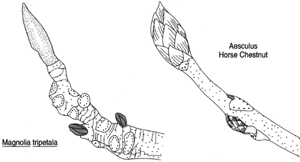Stems
 |
| Figure 32-1 Stem tips, showing terminal buds of Aesculus, the horse chednut, and Magnolia tripetala. The abundant leaf scars of Magnolia seem to confirm that the leaves are crowded into an umbrella-like circle.. |
A stem may be defined as something that bears leaves. But this definition is too simplistic; it needs to be expanded so as to answer some pertinent questions. From where does a stem come? What part of the seed produces it? When one dissects a seed, it is found to bear a seed coat or two and, within the seed coat, an embryo. The embryo consists of cotyledons (the seed leaves, which are food sources), a radicle (which grows downward upon germination to produce the root), and a plumule (which grows upward to produce the stem and leaves). The cotyledons are attached to the plumule. The seedling thus has two parts: the epicotyl (that part above the cotyledons) and the hypocotyl (that part below the cotyledons). Thus, a stem can be defined as that part of a plant above the hypocotyl.
Gymnosperms are entirely woody, while both woody and herbaceous forms occur in angiosperms. Angiosperms include both monocots and dicots. These differences create a need for several descriptions of stem anatomy.




